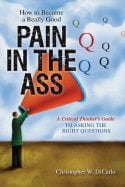
Prometheus Books, ISBN 978-1-61614-397-8
Given the morass of tree-wasting texts in the figmentalist section of any bookshop, an addition to the skeptical counter-attack is welcome a priori. DiCarlo hails from Canada, where he lectures on philosophy, and here he has gathered his thoughts on skeptical issues to produce a handbook for those new to critical thinking. Books on critical thinking are not new, however, and this relaxed, informal offering invites comparison with previous guides.
A couple of decades ago, for instance, Diane Halpern produced a substantial volume called Thought and Knowledge, an Introduction to Critical Thinking. This covers a greater range, in more detail, even extending to chapters on decision-making, problem-solving and creativity. Both books discuss logic and fallacies, yet while DiCarlo has a separate chapter for diagramming, he has decided not to bother with Venn diagrams as an instructional tool. He is certainly keen on diagrams and illustrations, though, and finds it necessary to illustrate the notion of geography with a little map of the world, adds a pencil drawing of Lady Gaga because she’s the subject of a syllogism, and provides a handy sketch of the big bang, when that is mentioned. When Bertrand Russell refutes an argument from ignorance with his orbiting teapot gambit, we get a photograph of a teapot, captioned Russell’s teapot.
Flicking through the book initially, two diagrams caught my eye and motivated my reading of it. These are The Relations of Natural Systems and The Relations of Cultural Systems. Placing critical thinking in these contexts looked well worth doing, and I looked forward to reading the details. This brought more disappointment. A daisy-chain of nodes like chemistry and partical [sic] physics forms a loop so that we can move from genetics round to galaxies. But three problems immediately arise: disciplines like cytology have the same status as material items like the solar system; cytology jumps straight to humanity, thence to ecology; all nodes also link, uselessly, to the central node, labelled The Relations of Natural Systems, i.e. the name of the diagram, as opposed to a substantive node itself. The other diagram is even more useless, as the casually clustered nodes (ethnicity, agriculture, sports (?), etc) only link to the central diagram-labelling node, and not to each other. No serious attempt is made to connect the two sets of relations, although DiCarlo provides a photograph of an onion.
This is not to say that the book’s contents are without value, but similar ground can also be found in several other books along with Halpern’s, such as How to Think About Weird Things, Critical Thinking for a New Age, by Schlick and Vaughn from over a decade ago.
It wasn’t this reviewer’s plan to fulfill the book’s title, but there we are. The drawing on p.333 of God’s Plan (!), didn’t help either.
Paul Taylor


